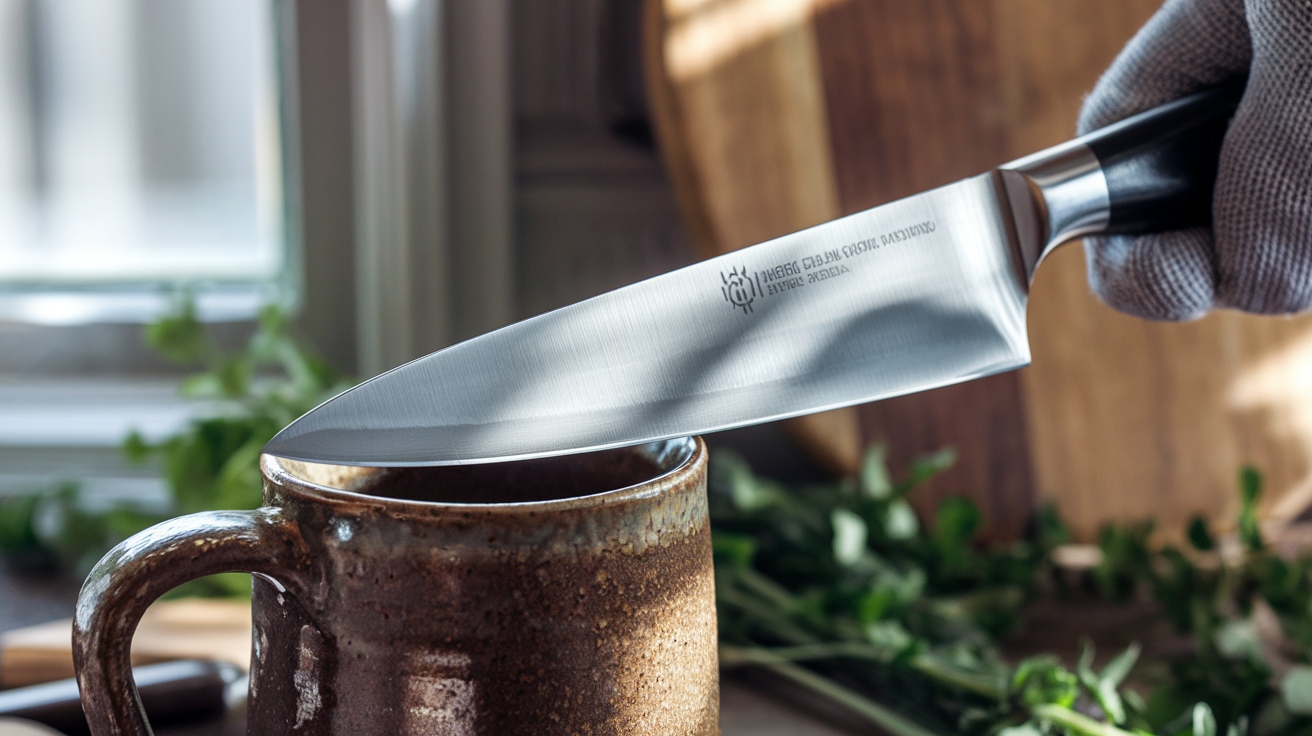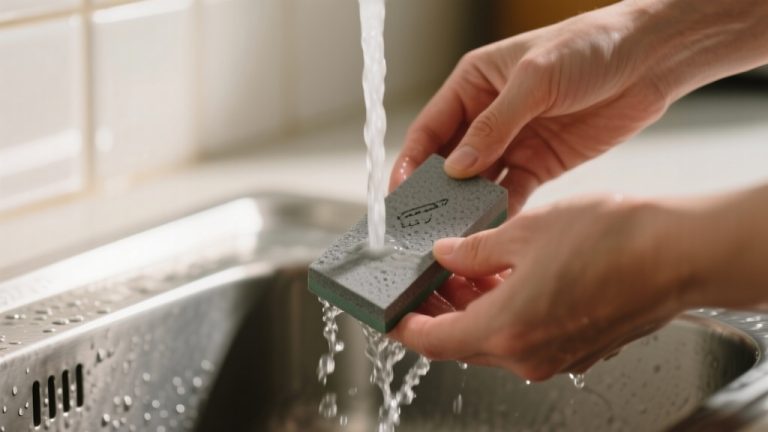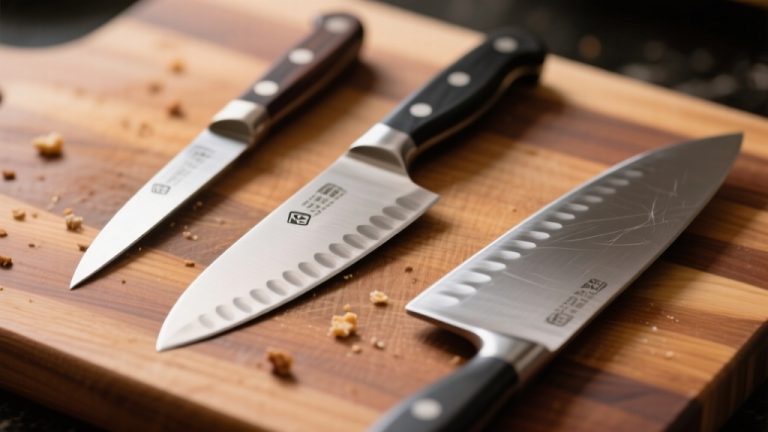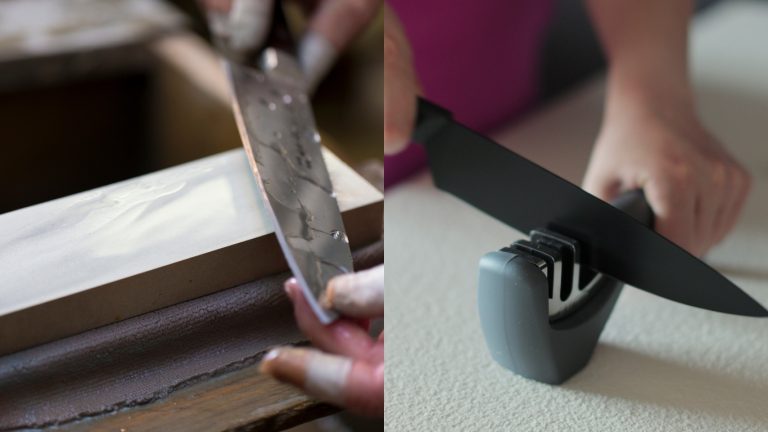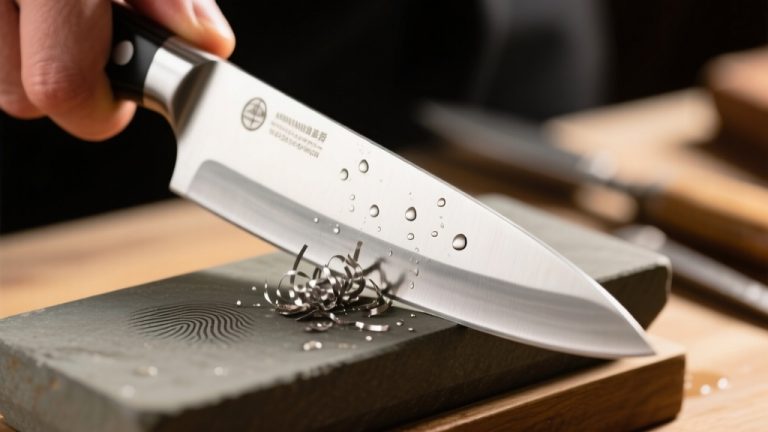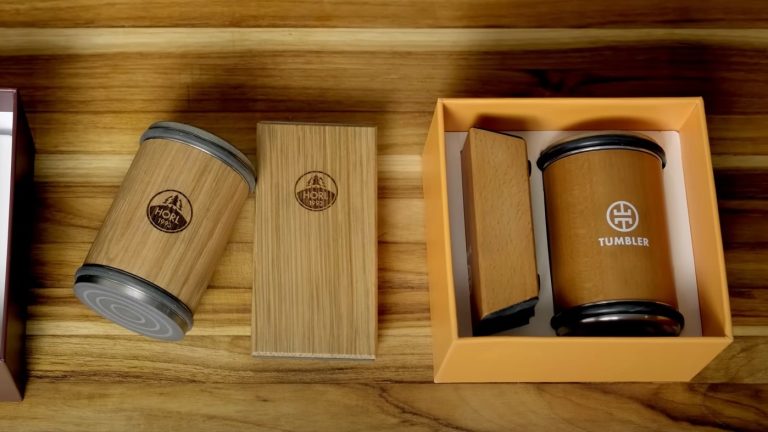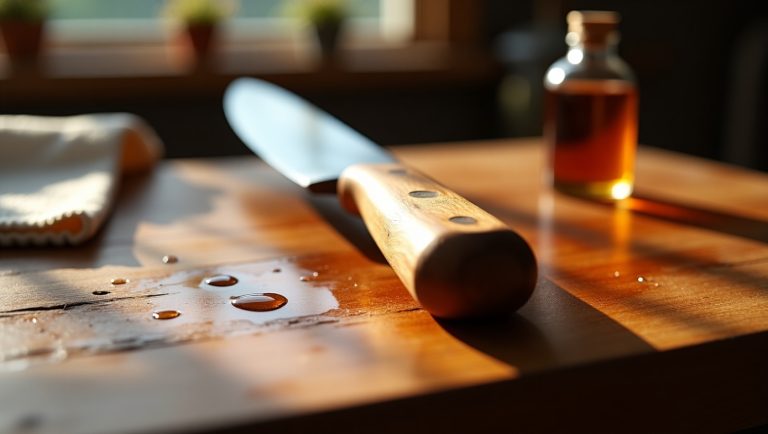How to Sharpen Knives Without a Knife Sharpener: Simple Hacks
You can sharpen your knives without a traditional sharpener by using everyday items you already have. Try the unglazed bottom of a ceramic mug or the edge of a porcelain plate.
For finer honing, a leather belt or sandpaper works wonders. Just maintain a consistent 20-degree angle and use even strokes.
Guarantee safety by keeping fingers clear, and remember to test sharpness on paper. There are even more techniques and tools you can explore for best results.
Key Takeaways
- Use the unglazed bottom of a ceramic coffee mug or the edge of a porcelain plate to sharpen your knife effectively.
- Employ a leather belt with honing oil, moving the blade back and forth for a fine edge.
- Try sanding with automotive wet/dry sandpaper, starting from 400 grit and progressing to 1000 grit for a polished finish.
- Test sharpness by slicing through paper or soft materials after sharpening to ensure effectiveness.
- Regularly clean and properly store your knives to maintain their sharpness and prevent damage.
Using Household Items for Sharpening
Sharpening your knives doesn’t always require a professional tool; in fact, you can use everyday household items to achieve a sharp edge.
Sharpening your knives can be easy and effective with just common household items at your disposal.
For instance, the unglazed bottom of a ceramic coffee mug makes an excellent makeshift sharpening stone.
You can also utilize the edge of a porcelain plate or even a leather belt with some honing oil. Regularly testing your knife’s sharpness using the paper test can help ensure your makeshift methods are effective.
Using sandpaper is another effective method; start with 400 grit for nicks, then finish with 1000 grit. Metal or diamond nail files can sharpen at a 15-20 degree angle, while cardboard helps hone your blade in a sawing motion.
Don’t overlook a stainless steel sink edge or even broken glass in emergencies just be cautious.
Natural Materials as Sharpening Tools
Natural materials can be surprisingly effective for sharpening knives, offering an accessible alternative to traditional tools. Stones like sandstone and slate provide varying grit levels, making them suitable for achieving a fine edge.
River stones, when soaked and prepared, can work wonders if you hold your knife at a 20-degree angle and stroke it diagonally. Natural stones are primarily used as finishing stones, enhancing the sharpening process further.
It’s important to note that sharpening angle affects the knife’s performance, so ensure you’re maintaining the right angle while using these natural tools. Bricks can serve as coarse sharpeners in emergencies, though they might risk damaging your blade.
For ideal results, consider using natural ngura stones, which create a slurry on sharpening stones, enhancing their effectiveness.
Automotive Parts for Knife Sharpening
When it comes to sharpening knives, many people mightn’t think of automotive parts as a viable option, but some do experiment with them.
While dragging a knife blade across a car window may come to mind, this method can be dangerous and lacks the precision required for effective sharpening.
Using automotive parts can risk damaging both your knife and the component itself. Though some might consider abrasive metal surfaces, they don’t offer the control you need.
Ultimately, it’s best to stick with dedicated sharpening tools designed for safety and effectiveness. A wide range of sharpeners is available to ensure optimal performance for all types of blades.
In fact, using dedicated sharpening tools can prevent the excessive metal removal associated with improper methods, which can significantly shorten your knife’s lifespan.
If you want ideal results, professional sharpening services are an excellent choice, ensuring your knives stay sharp without the risks associated with automotive parts.
Abrasive Materials for Effective Sharpening
When it comes to sharpening knives, using the right abrasive materials can make a significant difference. You can effectively utilize sandpaper, steel wool, and emery boards, each offering unique advantages for achieving a sharp edge.
Abrasive belts can also serve as an excellent alternative for more professional results, providing varying grit options for different sharpening needs. Additionally, using the correct sharpening angles is crucial for maximizing knife performance and longevity.
Sandpaper Techniques Explained
Sandpaper is an excellent tool for sharpening knives, offering a simple yet effective method to restore a dull blade. Start with coarse grit sandpaper (100-200) for dull edges, then progress to finer grits (400-1000) for polishing.
Opt for waterproof sandpaper and apply water to prevent clogging. Secure the sandpaper on a flat surface with tape or clamps, and maintain a consistent angle of 15-20 degrees while sharpening.
Use a single directional movement and apply even pressure to guarantee uniform sharpening. Regularly inspect the edge for sharpness and adjust the grit as needed. Additionally, cleaning the knife before sharpening is essential to ensure the best results, as this helps maintain blade integrity during the sharpening process.
Steel Wool Usage Tips
Although many may not consider it, steel wool serves as a versatile tool for sharpening and maintaining knife edges. Here are some tips to maximize its effectiveness:
| Tip | Details |
|---|---|
| Choose the Right Grade | Use fine steel wool (0000) for polishing; avoid coarse grades (000). |
| Apply Oil | Lubricate steel wool with oil to reduce friction and prevent scratches. |
| Stroke Direction | Always stroke in the direction of the blade’s edge for best results. |
| Control Pressure | Apply gentle pressure to avoid uneven sharpening and excessive metal loss. |
| Clean Post-Sharpening | After use, clean and dry the knife to prevent rust and maintain quality. |
Additionally, using fine steel wool is crucial as it provides a much better result compared to coarser grades, especially when dealing with light rust.
Emery Boards Advantages
Steel wool offers a handy sharpening solution, but if you’re looking for an alternative, emery boards present some compelling advantages.
These lightweight tools are incredibly portable, making them perfect for sharpening small blades like X-acto knives wherever you are. Plus, they’re versatile enough to tackle various small tools, including tweezers, and they’re cost-effective compared to specialized sharpeners.
Additionally, emery boards provide a temporary fix for dull blades, making them a suitable option when no other sharpening tools are available. Regular use of emery boards can help maintain optimal blade performance and prolong the life of your tools.
You likely have emery boards lying around your home or office, too! Beyond sharpening, they can also shape pencil points.
Sharpening With Glassware
Have you ever found yourself in a pinch, needing to sharpen your knife but lacking proper tools? You might consider using glassware as an emergency solution. Here’s how:
- Use a clean, broken glass bottle or a car window edge.
- Make certain the glass is free of debris to avoid knife damage.
- Hold the knife at a 20-degree angle for effective sharpening.
- Move the knife smoothly along the glass edge.
- Remember, this method is better for ceramic blades. Additionally, using a rusty knife can lead to health risks, so ensure your blade is in good condition before sharpening.
Safety Precautions When Sharpening Knives
When it comes to sharpening knives, prioritizing safety is essential to prevent injuries and guarantee a smooth process.
Start by wearing protective gloves like Kevlar or steel mesh to avoid cuts. Make certain your workspace is stable, well-lit, and free of obstacles. Always keep a first aid kit nearby, just in case. Using sharp knives is crucial, as they reduce the risk of slips and accidents.
When handling the knife, maintain a firm grip and position the blade away from your body. Move slowly and deliberately to avoid accidents, and stay aware of your surroundings, especially with pets and people nearby.
Techniques for Proper Knife Angle
Achieving the correct knife angle is vital for effective sharpening and can greatly impact your knife’s performance. A proper angle guarantees a sharp edge without damaging the blade.
Here are some techniques to keep in mind:
- Common Angles: Most knives are sharpened at a 20-degree angle.
- Adjust as Needed: Alter the angle based on your knife’s condition and desired sharpness; for instance, fillet knives typically require a sharper angle for precision.
- Stay Consistent: Maintaining the same angle during sharpening is essential for a uniform edge.
- Use Visual Aids: Tools or guides can help you measure and maintain the correct angle.
- Practice Regularly: The more you sharpen, the better you’ll get at keeping the right angle. Additionally, a sharp knife is crucial for safety in the kitchen.
Maintaining Your Knife’s Edge
After mastering the proper knife angle, the next step in keeping your knives sharp is maintaining their edge. Regular honing, cleaning, and proper storage are key to prolonging a knife’s sharpness.
It is essential to recognize the signs of dullness to ensure optimal performance and prevent accidents. Keeping knives in a dry place is crucial to prevent rust formation, which can further affect their sharpness.
| Practice | Tips |
|---|---|
| Honing Frequency | Hone after every few uses to prevent dulling. |
| Cleaning Methods | Use mild soap and water to avoid residue buildup. |
| Drying Techniques | Thoroughly dry your knives to prevent rust. |
| Storage Options | Store in a knife block to prevent dulling. |
| Edge Polishing | Use a leather strop to maintain blade integrity. |
Alternatives to Traditional Knife Sharpeners
When you find yourself without a traditional knife sharpener, several household items can come to the rescue. From ceramic coffee mugs to nail files, you have plenty of options right at your fingertips. Even natural materials and automotive parts can serve as effective sharpening tools in a pinch.
Additionally, regular honing of knives can help maintain the edge between sharpenings, allowing you to use these alternative methods more effectively.
Household Items Techniques
Every kitchen has items that can double as effective knife sharpeners, offering convenient alternatives to traditional tools.
You can easily use these household items to bring your dull knives back to life:
- Ceramic items: The unglazed bottom of coffee mugs works well. Ceramic surfaces provide a temporary sharpening solution that helps to refresh the knife’s edge.
- Leather belts: They can hone your knife by removing burrs.
- Sandpaper: Start with coarse grit and finish with fine for a polished edge.
- Nail files: Use small back-and-forth motions with metal or diamond files.
- Aluminum foil: Fold it into a square and move the knife in and out for sharpening.
Natural Material Options
While household items can effectively sharpen knives, natural materials provide an alternative that many enthusiasts prefer for their performance and longevity.
Arkansas stones, for example, are composed of novaculite and offer a fine grain for precise sharpening, requiring oil as a lubricant. Soft Arkansas stones are particularly useful for initial sharpening stages, making them a versatile choice for various types of knives.
Coticule stones from Belgium, made with spessartine, create a sharpening paste during use, enhancing effectiveness.
Japanese natural stones (JNATs) are also popular, known for their superior polishing capabilities and consistent results when using water and slurry.
Although these natural options can be time-consuming and vary in effectiveness, their longevity and eco-friendliness make them appealing choices for those seeking a refined sharpening experience.
Automotive Parts Solutions
If you’re looking for innovative ways to sharpen your knives without a traditional sharpener, automotive parts can offer some surprisingly effective solutions. One popular method is using automotive wet/dry sandpaper.
It allows for flexibility in angles and lets you progress through grits for a refined edge. Regular knife sharpening is essential for improving safety and efficiency during cutting tasks.
Here are some effective automotive alternatives:
- Sandpaper Method: Perfect for achieving a durable convex edge.
- Ceramic Mug or Plate: Use the unglazed bottom for quick sharpening.
- Leather Belt Stropping: Hone your knife edge effectively between sharpenings.
- Mousepad Base: Creates stability for sandpaper sharpening.
- Emery Paper: Ideal for flat surfaces like glass.
Frequently Asked Questions
Can I Use My Knife on Any Surface to Sharpen It?
You can’t just use any surface to sharpen your knife.
While unconventional items like ceramic mugs or aluminum foil might seem tempting, they often lead to inconsistent results and can damage your blade.
It’s better to stick with proper tools like whetstones or flat stones for effective sharpening.
How Often Should I Sharpen My Knives Using These Methods?
You should sharpen your knives based on how often you use them. For general home use, aim to sharpen them 2 to 3 times a year.
If you’re in a professional kitchen, you might need to sharpen every 1 to 2 months. Regular honing can help extend the time between sharpenings.
Always pay attention to the cutting materials and storage conditions, as these factors can influence how quickly your knife loses its edge.
What Types of Knives Can Be Sharpened Without a Sharpener?
When you think of sharpening knives, imagine the sleekness of a Japanese blade versus the ruggedness of a German knife.
You can sharpen stainless steel and high-carbon steel knives using DIY methods, like a ceramic mug’s bottom or sandpaper.
However, be cautious with ceramic knives, as they don’t respond well to these techniques.
Will These Methods Work for Ceramic and Specialty Knives?
These methods generally won’t work well for ceramic and specialty knives.
Ceramic knives need diamond stones and high grit for effective sharpening, while specialty knives require precise techniques tailored to their materials.
Using DIY methods could damage your knives or fail to sharpen them adequately.
For best results, consider investing in proper tools or professional services to maintain the longevity and performance of your ceramic and high-end knives.
How Can I Tell if My Knife Is Sharp Enough After Sharpening?
Imagine slicing through a ripe tomato smooth and effortless. That’s how you know your knife’s sharp enough.
Test it with the fingernail method: if it glides through with little resistance, you’re good.
Try the paper test, too; a sharp knife should cut cleanly without tearing.
If you can easily whittle soft wood or cut a free-hanging hair, you’ve hit the sharpness jackpot.
Keep these tests handy for peak performance!
Sharp Knives, Smart Solutions: The Power of Everyday Items
To summarize, sharpening your knives without a traditional sharpener is entirely possible with a bit of creativity and resourcefulness.
Whether you’re using household items, natural materials, or even automotive parts, you can restore your knife’s edge effectively. So, why rely solely on store-bought tools when everyday objects can do the trick?
By practicing the techniques outlined and maintaining your knife, you’ll always have a sharp blade ready for any culinary challenge ahead.

